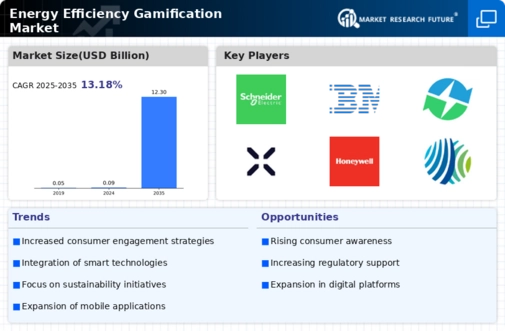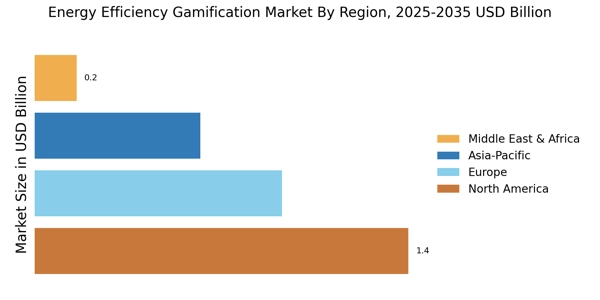The Energy Efficiency Gamification Market is currently characterized by a dynamic competitive landscape, driven by increasing consumer awareness of sustainability and the need for energy conservation. Key players such as EcoAction (US), Schneider Electric (FR), and Honeywell (US) are at the forefront, employing diverse strategies to enhance their market presence. EcoAction (US) focuses on innovative gamification techniques to engage users in energy-saving behaviors, while Schneider Electric (FR) emphasizes digital transformation and smart technology integration to optimize energy management solutions. Honeywell (US) is leveraging its extensive portfolio to create comprehensive energy efficiency programs that appeal to both residential and commercial sectors. Collectively, these strategies contribute to a competitive environment that is increasingly centered around technological advancement and user engagement.
In terms of business tactics, companies are increasingly localizing their operations and optimizing supply chains to enhance efficiency and responsiveness to market demands. The Energy Efficiency Gamification Market appears moderately fragmented, with a mix of established players and emerging startups. This structure allows for a variety of approaches to energy efficiency, as companies seek to differentiate themselves through unique offerings and localized solutions. The collective influence of these key players shapes market dynamics, fostering an environment where innovation is paramount.
In August 2025, EcoAction (US) launched a new mobile application designed to gamify energy savings for residential users. This application incorporates social features that allow users to compete with friends and neighbors, thereby enhancing user engagement and promoting energy-efficient behaviors. The strategic importance of this launch lies in its potential to significantly increase user participation in energy-saving initiatives, thereby driving demand for EcoAction's services and reinforcing its position in the market.
In September 2025, Schneider Electric (FR) announced a partnership with a leading technology firm to develop AI-driven energy management solutions. This collaboration aims to integrate advanced analytics into Schneider's existing platforms, enabling users to optimize their energy consumption in real-time. The strategic significance of this partnership is profound, as it positions Schneider Electric at the cutting edge of technological innovation in energy efficiency, potentially setting new industry standards.
In October 2025, Honeywell (US) unveiled a new suite of energy efficiency tools aimed at commercial buildings, which includes gamification elements to encourage employee participation in energy-saving practices. This initiative is particularly noteworthy as it reflects a growing trend towards engaging end-users in energy management, thereby enhancing the overall effectiveness of energy efficiency programs. The strategic importance of this development lies in its ability to create a more participatory approach to energy conservation, which could lead to substantial energy savings across various sectors.
As of October 2025, the competitive trends in the Energy Efficiency Gamification Market are increasingly defined by digitalization, sustainability, and the integration of artificial intelligence. Strategic alliances are becoming more prevalent, as companies recognize the value of collaboration in driving innovation and enhancing service offerings. Looking ahead, competitive differentiation is likely to evolve from traditional price-based competition to a focus on technological innovation, user engagement, and supply chain reliability. This shift underscores the importance of adaptability and forward-thinking strategies in navigating the complexities of the energy efficiency landscape.


















Leave a Comment